In wine-speak terroir — a concept enveloping all of the components present while the vine grows — is often king. Elements such as soil (and sub-soil), wind, sun, grower influence (such as trellising), slope, wildlife, ecosystem…all of these are part of terroir and many wine drinkers and makers insist that terroir is an essential cornerstone in the taste of a wine.

France’s Languedoc region is an example of a Mediterranean climate. Credit: Jill Barth
What Is Climate?
While each influence is a relevant slice of the overall pie, one might say that the big kahuna in terroir is climate. Climate is comprised of the conditions in the atmosphere of a region of the Earth’s surface.
“The difference between weather and climate is a measure of time,” says the NASA website. “Weather is what conditions of the atmosphere are over a short period of time, and climate is how the atmosphere “behaves” over relatively long periods of time.” Long time generally means at least 30 years, which is food for thought for most wine drinkers (most of us are at least 30, right?) as we contemplate concepts such as climate-change and climate-chaos during our lifetime.
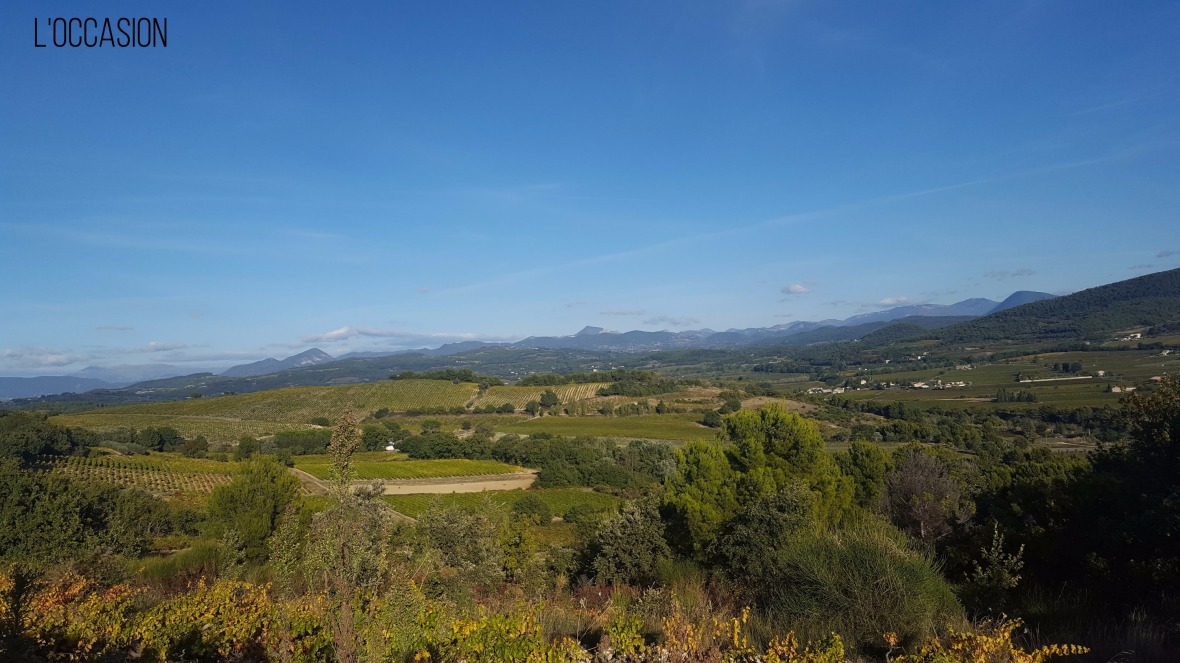
Provence and the Southern Rhône are also Mediterranean climates. A view of Rasteau from the elevated vineyards of Domaine des Coteaux des Travers. Credit: Jill Barth
Growers pay attention to climate prior to planting, just as a home gardener in Minnesota avoids putting a cactus in their landscaping — as the year and years go by, climate will encourage or discourage outcomes for the ecosystem. Wine regions are classically defined by climate, perhaps more than anything else. Take for example a Mediterranean climate. “Due to the geography of the old world wine regions of Europe and the use of the Köppen system, wine production has become synonymous with Mediterranean climates,” says author Gregory Jones of the Department of Environmental Studies at Southern Oregon University.
Picpoul and the Mediterranean Climate
To put this into perspective, let’s look at a grape variety that thrives in basically one specific climate, Mediterranean. Picpoul Blanc (Picpoul for short; there are gris and noir versions, but these aren’t symbolic of the variety) is a grape native to the south of France, where it hails from a Côteaux de Languedoc appellation by nearly the same name, Picpoul-de-Pinet.
Picpoul also flourishes in the southern Rhône Valley, including Châteauneuf-du-Pape where it is a permitted grape. Picpoul is allowed in some wines of Provence and is native to the Vaucluse. These days, it is gaining a touch of popularity in California, with Tablas Creek Vineyard in Paso Robles and Acquiesce Winery in Lodi making highly-regarded bottles, which have a bit of a cult following. However, according to Susan Tipton, proprietor and winemaker at Acquiesce Winery, “just a few acres of this delightful grape planted in the US”.
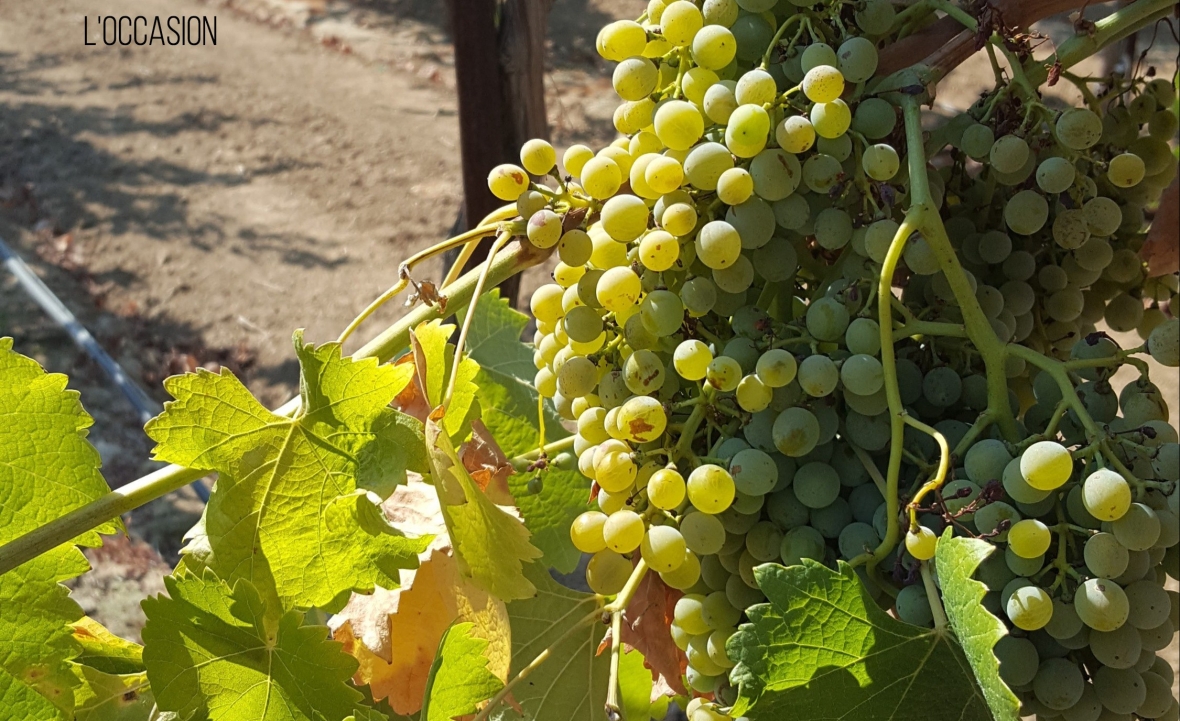
Picpoul grows in the vineyard at Acquiesce Winery in Lodi, CA. Credit: Jill Barth
In France origin is of total supremacy — wine-growing regions adhere to strict regulations about what can be planted, where it can be planted, how it can be planted — all of this is reflected back to the consumer on the label with an indication of where it was grown. The more specific spot on the label, the more specific origin adherence. Interestingly, the appellation (origin) for Picpoul honors the variety, Picpoul-de-Pinet.
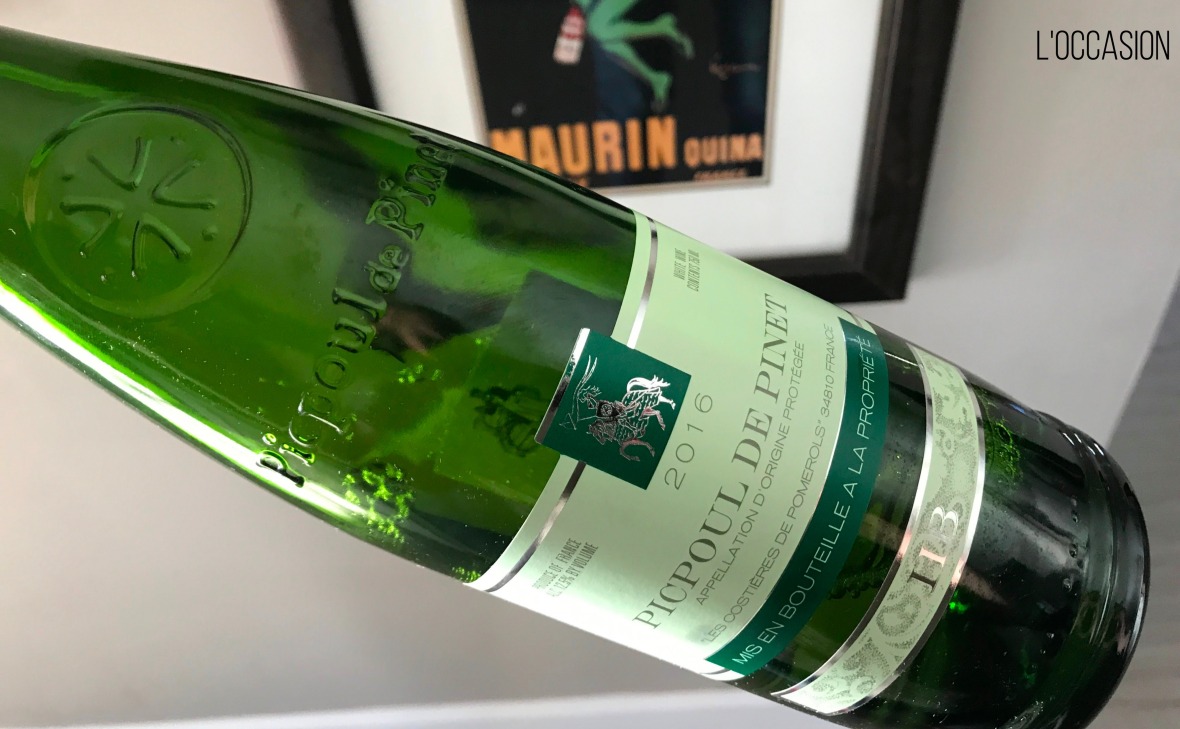
Cave de Pomerols HB Picpoul de Pinet 2016 in the classic bottle. Credit: Jill Barth
So what does Picpoul like about the Mediterranean climate? What can’t she get elsewhere, say Finger Lakes or Champagne? The grape adores heat and sand and is prone to fungus. The Mediterranean climate consists of hot dry summers and warm springs and falls. Relatively light rainfall, temperatures generally above freezing even in the winter and lots of hot wind help Picpoul thrive. Cooling sea breezes from the Med chill the berries overnight. This maintains acid and prevents over-ripening which can be an issue in hot, long growing seasons.
Distinct and Delicious
Picpoul’s naming origin means lip stinger for the acidic bite in the mouth of the drinker — this variety is notably high in acid, particularly for such a hot growing region. This explains what makes the grape unique, responsible for commercial thriving as well as ecological. Picpoul-de-Pinet is refreshing and citrus-packed, appreciated as a blending grape to lend brightness and minerality and delicious as a single element in a chilled bottle on a big-blue-sky day.
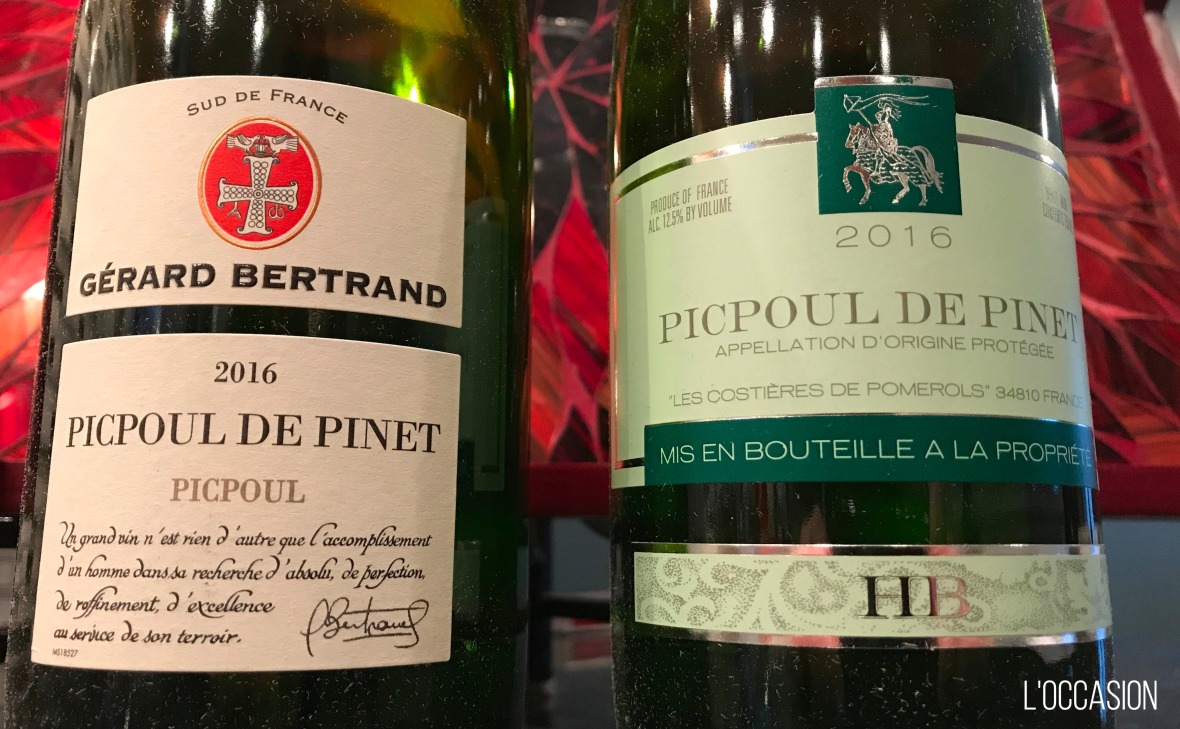
Gérard Bertrand Terroir Picpoul de Pinet 2016 is a classic. Bertrand is a must-know producer in the Languedoc. Shown here with Cave de Pomerols HB Picpoul-de-Pinet 2016. Credit: Jill Barth
A chilled bottle – and this, too, is one of the reasons to celebrate Picpoul-de-Pinet as unique. It generally comes in a clean green, Alsace-shaped bottle. The distinctive Languedoc Cross is embossed in the glass. There is Sud-de-France and Occitanie pride in Picpoul-de-Pinet — a character of the land and a wine to explore with the cuisine and landscape of the Languedoc. The wine is notoriously friendly with shellfish, seafood, cheese, and charcuterie. It is clear and light, delicate and fresh, structured and balanced. For a lasting impression of the Mediterranean climate in which it thrives, Picpoul-de-Pinet is a postcard of flavor.
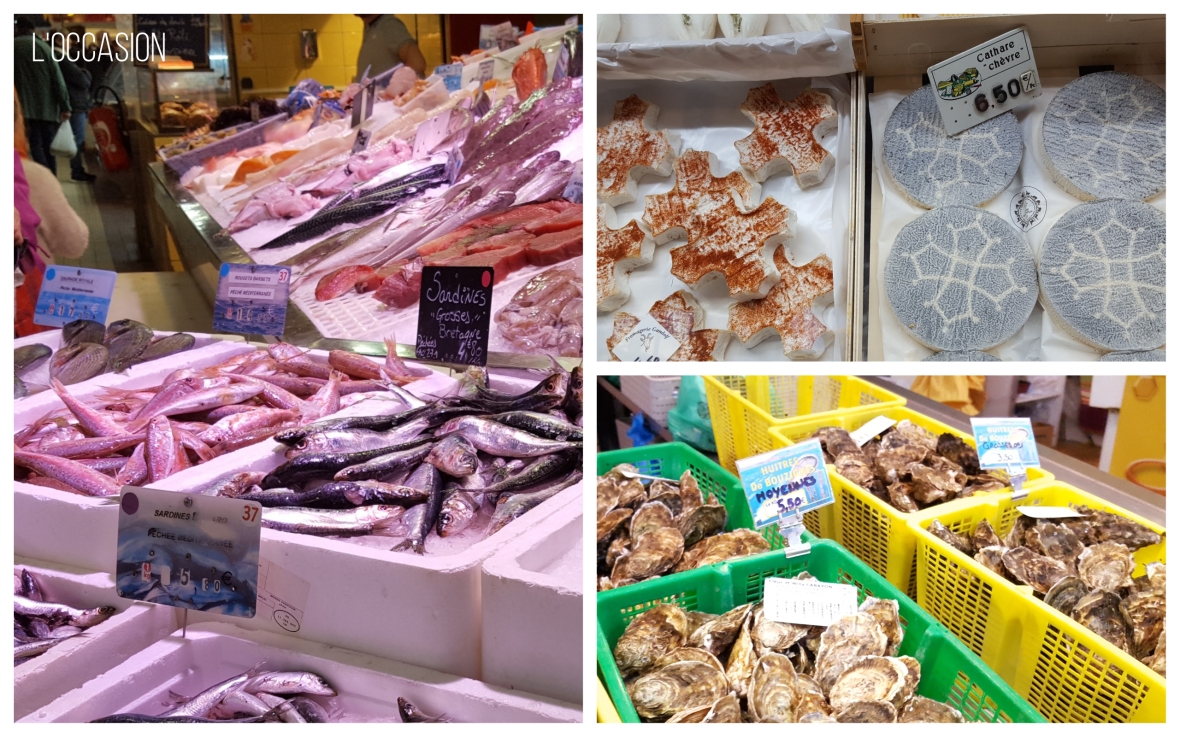
Languedoc food to pair with Picpoul – note the Languedoc cross on the cheese. Credit: Jill Barth
French Winophiles
On the third Saturday of each month, The French Winophiles writers collaborate about a particular grape, style or region. April’s focus, in time for spring and summer, is Picpoul. All are welcome to join our Twitter chat on Saturday, April 21st at 10 am central. Search for the hashtag #Winophiles to follow along or peruse the tweets later. All of this is packed in the collection:
Michelle of Rockin Red Blog says, “Picpoul…Take Me Away“
Wendy of A Day in the Life on the Farm encourages us to Pick a Picpoul to Enjoy al Fresco This Summer
Susannah of Avvinare features Picpoul de Pinet – A Refreshing White from the Languedoc
Here on L’Occasion we share Mediterranean Bliss: Picpoul-de-Pinet
Jeff of FoodWineClick! pairs Picpoul de Pinet and Steak Tartare Redemption
Nicole of Somm’s Table writes Cooking to the Wines: Font-Mars Picpoul de Pinet with Crab Cakes and Fennel-Apple Salad
Payal of Keep the Peas posts A Lip-Smacking Lip-Stinger: Picpoul de Pinet
David of Cooking Chat makes a case for Picpoul Wine with Pesto and Other Pairings
Lauren of The Swirling Dervish says Picpoul de Pinet: Your Go-To Wine for Spring
Lynn of Savor the Harvest asserts The Single Variety Wine For Summer- Picpoul de Pinet
Gwendolyn of Wine Predator has Picpoul Goes Southern with Shrimp and Grits
Rupal of Syrah Queen will also have a title soon.
Jane of Always Ravenous pairs Halibut with Spring Vegetables and Picpoul Wine
Robin of Crushed Grape Chronicles shares Picpouls from Pinet and California and a Seaside Pairing
Our host, Culinary Adventures with Camilla, is Pairing Bourride à la Sétoise with Picpoul From France to California’s Central Coast.
Some wines appearing on L’Occasion are media samples. All opinions are my own and no compensation is provided.

Believe it or not, Picpoul actually grows well in parts of Texas as well. Great information beautifully written as always Jill. Thank you. Cheers.
LikeLiked by 1 person
I would love to try that – I need more TX wine in my life. Keep me posted of good bottles to try!
LikeLike
I’m a big fan of Picpoul-de-Pinet. It’s really taken off in recent years — you now find it on many restaurant and wine bar lists here in France.
LikeLiked by 1 person
I’ve noticed that too – in fact I think it does great with food and some bottles have just the right amount of acid to be quite versatile. Thanks for reading and sharing your experience with Picpoul!
LikeLiked by 1 person
Your pictures of the region and its bounty of seafood put Picpoul in proper context – especially for someone who hasn’t (yet) visited it. I hope to get there someday, and I already know what I will be eating/drinking!
LikeLiked by 1 person
It’s the highlight of every trip: eating and drinking!
This was a fun month – and now we all want oysters 🙂
LikeLiked by 1 person
Jill, I learned something new! Thank you. Picpoul sounds like it would grow well in southern Oklahoma even w the occasional two weeks every other year of below freezing temps. Oklahoma does hot dry & drought very well. I might need to start a vineyard! Cheers.
LikeLiked by 1 person
That is your calling! If you do I’ll help harvest.
Thanks for reading and commenting. 🙂
LikeLiked by 1 person
It’s pretty impressive that Picpoul retains all that acid in the Mediterranean heat and sun. Being acid-hounds, we love it!
LikeLiked by 1 person
It is a treasure down there!
LikeLike
I know that this is supposed to be an acidic wine but I didn’t get that on my palate. I thought is was smooth and full. I loved it.
LikeLiked by 1 person
I’m with you – lip-stinger doesn’t seem apt!
LikeLike
Great information on why terroir matters especially the Mediterranean climate and Picpoul. And yes, oysters please!
LikeLike
A really great discussion of the interplay between a grape and it’s environment. Cheers!
LikeLiked by 1 person
Thanks Nicole!
LikeLike
Good context on how climate conditions contribute to the wine we enjoy! I haven’t tried any Picpoul from California yet, curious about that.
LikeLiked by 1 person
Thanks David – I’m sure you’ll have a bottle soon!
LikeLike
Excellent post, great detail!
LikeLiked by 1 person
Thank you! Glad you enjoyed!
LikeLike
Love this: “For a lasting impression of the Mediterranean climate in which it thrives, Picpoul-de-Pinet is a postcard of flavor.” And I love the context your present! Lots of great info here– Thanks!
LikeLiked by 1 person
Thanks Gwen – a totally interesting topic!
LikeLike
Interesting to read why Picpoul does well in a Mediterranean climate. I had one around a month ago from a small Texas producer… don’t know where in Texas, I have to look at my notes, but it was nice. But I love Picpoul from Southern France, I drink it a lot during the summer and many restaurants will offer it by the glass in July and August.
LikeLiked by 1 person
It seems to have a good reception! We drink it in Provence and the Languedoc – by the glass would be a welcome option at restaurants stateside. Thanks for your thoughts!
LikeLike
My first Picpoul de Pinet was at The Loft restaurant in Ashland, Oregon. Reading your description of climate, and understanding where Picpoul thrives, I’m wondering when it might show up in the Applegate or Rogue valley. Although those valleys are a mixture of intersecting geological formations and soils, there is sand along the river valley!
LikeLike
Great post, you have pointed out some fantastic points. Thanks for sharing.
Game Lover – http://subway-surfer.com/
LikeLike
Thanks James!
LikeLike
You speak your mind and give people some new knowledge every time you post and I admire that.
https://games.lol/
LikeLike
Thank you! I’m glad it is helpful!
LikeLike